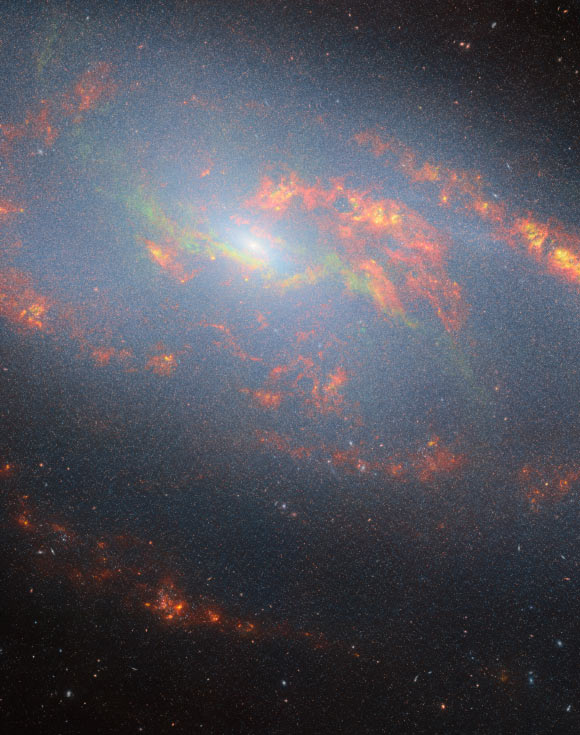NASA has released a stunning new image snapped by the NASA/ESA/CSA James Webb Space Telescope of the active, central part of the nearby spiral galaxy Messier 106.
This Webb image shows Messier 106, a spiral galaxy located 20 million light-years away in the constellation of Canes Venatici. Image credit: NASA / ESA / CSA / Webb / J. Glenn.
Lying over 20 million light-years from us in the small northern constellation of Canes Venatici, Messier 106 is one of the brightest and nearest spiral galaxies to our own Milky Way Galaxy.
Also known as M106 or NGC 4258, the galaxy was discovered by Charles Messier’s observing assistant, Pierre Méchain, in 1781.
“Despite carrying his name, Messier 106 was neither discovered nor catalogued by the renowned 18th century astronomer Charles Messier,” the Webb astronomers said in a statement.
“Discovered by his assistant, Pierre Méchain, the galaxy was never added to the catalogue in his lifetime.”
“Along with six other objects discovered but not logged by the pair, Messier 106 was added to the Messier catalogue in the 20th century.”
Messier 106 is similar in size and luminosity to our galactic neighbor, the Andromeda Galaxy.
Though it measures more than 130,000 light-years from edge to edge, the vast distance between it and the Milky Way renders Messier 106 minuscule when seen from Earth.
At Messier 106’s heart lies a very active supermassive black hole with a mass of about 40 million solar masses.
Unlike the black hole at Milky Way’s center, which pulls in wisps of gas only occasionally, Messier 106’s black hole is actively gobbling up material.
“As the gas spirals towards Messier 106’s black hole, it heats up and emits powerful radiation,” the astronomers said.
This new image of Messier 106 was captured with Webb’s Near-InfraRed Camera (NIRCam).
“This observation was taken as part of a dedicated programme to study the galaxy’s active galactic nucleus, the galaxy’s bright central region that is dominated by the light emitted by dust and gas as it falls into the black hole,” the researchers said.
“The blue regions in this image reflect stellar distribution throughout the central region of the galaxy.”
“The orange regions indicate warmer dust and the stronger red hues represent colder dust.”
“The teal, green and yellow tones near the centre of the image depict varying gas distributions throughout the region.”
Messier 106 also has a remarkable feature — it is known to have two ‘anomalous’ extra arms visible in radio and X-ray wavelengths, rather than in the visible.
“Unlike the normal arms, these are composed of hot gas instead of stars,” the scientists said.
“Astronomers believe these extra arms result from the black hole’s activity, a feedback effect seen in other galaxies as well.”
“They are likely caused by outflowing material produced by the violent churning of gas around the black hole, creating a phenomenon analogous to a wave crashing up out of the ocean when it hits a rock near the shore.”

